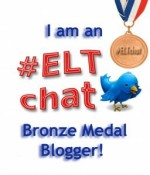Love it, hate it, feel guilty about it…or just mystified?
The first #ELTChat on Twitter 7th November 2012 discussed the phonemic chart (and script) asking ‘Do you use it? Why/why not? And how?’
There were quite a few participants who fell into the ‘love it’ category:
@worldteacher ‘I’m a huge fan of the phonemic chart and use it in every lesson.’
@BobK99 ‘Can’t see how anyone can teach English effectively WITHOUT IPA.’
@Julian_L’enfant ‘I use the phonemic chart with learners of all ages. An excellent resource & important for learner autonomy.’
Others, such as @teflerinha, @KerrCarolyn , @TEFL Geek , @jo_cummins, @sueAnnan who like using it, but perhaps in more of an ad hoc way.
And those who didn’t use it, such as @bnleez, @michaelegriffin, @theteacherjames and @garyJones 01 (who preferred to use rhymes and tonguetwisters)
So the stage was set for a good discussion from different angles, though there were probably more people in favour of using the chart than against. The arguments on both sides are set out below.
Overwhelming, intimidating?
It’s complicated, takes time and students don’t know it (@michaelegriffin)
@bnleez: Pronunciation varies to such a degree, I find the Phon. chart would cause more confusion for learners than it needs to be
I found it intimidating as a new teacher, so what about students? (@jo_cummins)
Agree it can be overwhelming for ss and worse for ss without Roman alphabet perhaps? (@teflerinha)
Or empowering?
But using symbols empowers students (@worldteacher)
If trained in the chart, students can get word outside classroom and note down pron themselves (@TEFLGeek)
I agree with learner autonomy (@jo_Cummins)
Teaching in France, ‘improved pronunciation’ is one of the most common objectives (@KerrCarolyn)
I’ve found students who have followed courses w/pron more resourceful than new students entering the school (Julian_l’Enfant)
Unnecessary?
ELLs can use online dictionaries with sound files, so IPA is redundant (@bnleez)
I’m still not convinced the sts need to ‘see’ the pronunciation, just hear & reproduce it. (@theteacherjames)
Or a useful visual aid?
Students need to have constant access to internet and to already be able to differentiate between sounds (@TEFLGeek)
Great for use at home or if you have tech in the classroom – otherwise I’ll stick to paper charts & flashcards! (@worldteacher)
seeing it helps with highlighting the difference in form (@sueannan)
doesn’t seeing it help lock it into the memory? (@shaunwilden)
Some find it reassuring – identify visually what ears can’t deal with (@KerrCarolyn)
Complicated?
It’s complicated, takes time and students don’t know it (@michaelegriffin)
@bnleez: Pronunciation varies to such a degree, I find the Phon. chart would cause more confusion for learners than it needs to be
Or not so much…?
it just looks intimidating but once you start to study it it is logical. (@jo_Cummins)
Many symbols (e.g. consonants and some dipthongs) are self-evident (@teflerinha)
A restrictive model?
Does the idea of a ‘model’ (as suggested by using a uniform chart) undermine local accents & non-native teacher …(@laurahaha)
@teflerinha thought that different allophones (versions of the same phoneme) could be included in each phoneme)
There was also mention of the American IPA- see links below.
Unsuitable for learners without a Roman script, those with literacy problems or YLs?
Previous #ELTChat on similar subject made the point that study showed learning symbols made students with different alphabet more anxious (@michaelegriffin)
Interestingly my CELTA tutor told me its no problem for Korean/Japanese Ss to pick up easily because new scripts r easy (@michaelegriffin)
A new script shouldn’t be too hard. Japanese and Chinese know thousands of characters. And most consonants are the same.(@EBEFL)
@Marisa_C and @teflerinha both raised the point that it might not be a good idea for students who were already struggling with literacy (though @teflerinha would still probably use a few key symbols such as schwa)
There was also a brief discussion about YLs, and here opinion was divided.
I use it with adults but hardly use the symbols with YLs (@prese1)
When teaching YLs we’d use it as a secret code; Lee the Lion and Sid the Snake liked certain types of words.(@Julian_l’Enfant)
What does the chart or phonemic script offer in addition to the teacher’s other resources?
The teacher can model pronunciation (@bnleeez) but..
The chart can help with this as at least Underhills’ version (see link below) shows the mouth positions as well (@teflerinha)
It can really help with showing connected speech. E.g.(@harrisonmike):
/t̬ʊwæplz/
This shows the intrusive ‘w’.
@theteacher James suggested it would be as easy to write ‘tu wapples’
But others disagreed:
No- could be ‘too wapplz’ (@Marisa_C)
No, because people write things phonetically in very different ways (@teflerinha)
‘Tu wapples’ could cause spelling mistakes (@harrisonmike)
@Harrisonmike also described giving Farsi and Urdu speakers text in script to work out, and @teflerinha agreed that this was useful. For example:
Would you like to…? Could be represented as /wʊdʒə’laɪktə/, which shows how this phrase sounds in connected speech much more effectively than the words alone.
Other ways to use the chart or IPA
@Kerrcarolyn said ’11 Colour vowel sounds are great. I use the colors with kids and they love coloring words and poems’
@harrisonmike ‘good one is with minimal pairs and a maze on the board. eg. forked paths, one is 15, the other 50, or bin/bean (Pronunciation Games)– this is a link to Mark Hancock’s blog, with lots of Pron Games and activities.
@musical pass the symbol (@worldteacher)
Great activity from Arizio Sweeting’s new blog Pronunciation Central on Chasing and Tagging Phonemes (and other pron activities too)
@Bobk99 ‘s Phonemic Bingo
For a much longer list of activity ideas see the previous #eltchat on a similar subject
Different charts
This is Adrian Underhill’s chart and blog . Also see @CGoodey’s blog entry on Adrian’s presentation and her aha moment on using the chart.
On YouTube you can find Adrian Underhill going through the chart. Part 1 is here.
a The British Council interactive char also shows sounds in words with sound at beg, middle and end . You can click to hear these and it deals with allophones – the way phonemes can be slightly different in these different places.
@julian_l’Enfant suggested Celce-Murcia Brinton & Goodwin’s for an American English chart (there is also one on Adrian Underhill’s blog, link above)
@ElaWassell gave the link to Macmillan’s The sounds app
@michaelegriffin gave us a link to five charts, including the two above.
@harrisonmike shared a link to a tool which will transcribe into IPA for you (not perfectly)
Other Links
This is the most useful pron site I’ve found– really helps for teaching HOW 2 make the sounds (@phil3wade)P
Phonetic typewriter which might come in handy for worksheets. (@EBEFL)
Cambridge has some awesome phon games (@Marisa_C)
Useful blog post from @clil2climb about teaching pronunciation (@ElaWassell)
@cybraryman1 My Pronunciation page: Phonological Awareness
#ELTChat takes place every Wednesday at 12pm and 9pm UK time. Do join us!





















How a book changed my life
By Ildar Sagdejev (Specious) (Own work) [Public domain], via Wikimedia Commons
Finally there is a focus on opinion or comment adverbs, before a speaking activity to round up the lesson, about the topic of books and reading.
The lesson would be suitable from B1 upwards.
Download lesson plan PDF here: ELT Resourceful – How a book changed my life
Look here for more free downloadable lessons
Share this:
1 Comment
Filed under Downloadable lesson materials, Exploiting authentic recordings and videos, Listening, Materials development, Pronunciation, Vocabulary
Tagged as authentic materials, comment adverbs, efl, elt, ESL, listening, listening skills, materials, reading, resources, speaking, video, video lesson, world book day